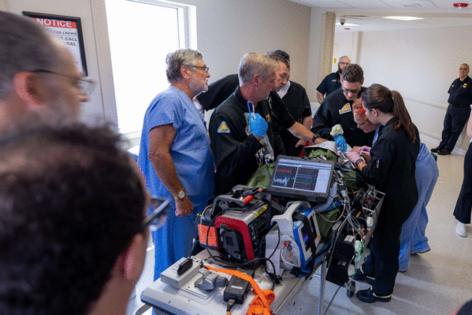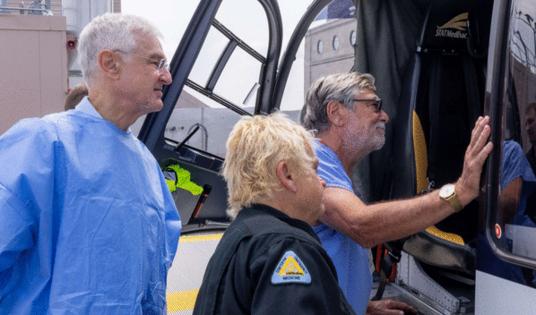Pitt, with military funding, develops technology to administer lifesaving care with minimal human intervention
Published in News & Features
PITTSBURGH — On four occasions last year, medical helicopters flew over Pittsburgh transporting not injured humans, but wounded pigs.
The pigs — bleeding heavily from the abdomen — were stabilized in the air by an autonomous medical intervention system developed by the University of Pittsburgh as part of a military-funded study with the potential for "groundbreaking" advances in health care.
"What we did with the Department of Defense was try to solve their number one cause of preventable death on the battlefield," said Ronald Poropatich, director of the Pitt Center for Military Medicine. "This is the future of medicine, whether it's military or civilian."
In the five-year proof-of-concept study — published Friday in the journal Intensive Care Medicine Experimental — Pitt researchers and physicians worked with computer scientists at Carnegie Mellon University to build the ReFit (Resuscitation based on Functional Hemodynamic Monitoring) system. About the size of a microwave, the computer system can function as a highly trained critical care physician, administering fluids, blood and medication without human intervention. It was funded by a $3.712 million grant over four years from the Department of Defense.
In the experiment, four pigs were fully anesthetized in accordance with animal research protocols and then given liver lacerations in a laboratory to mimic a gunshot wound to the abdomen or other non-compressible hemorrhage.
The pigs were allowed to bleed for 30 minutes and then connected to the ReFit system. At this point, a human medical professional still has to manually insert an IV, but after that, no human intervention is required.
Two of the pigs were placed on a stretcher and taken to the hospital helipad, where they flew for several hours around Pittsburgh. The other two pigs were taken via ambulance to the Allegheny County Airport, and then flown on a medical helicopter as far as Kittanning and then back to Oakland.
The ReFit system was able to stabilize the pigs and return them in adequate condition for life-saving surgery.
"For the first time in the history of medicine, we took an animal in a critical state onto a helicopter and autonomously brought it back healthier than when it was placed in emergency transport hours earlier," said Michael Pinsky, professor of critical care, bioengineering and critical and translational medicine at Pitt and lead author of the study. "This has profound implications for trauma resuscitation in the field and of course in military medicine."
In emergency medicine, physicians have long referred to the "golden hour," an idea dating back to World War I that it is critical to get a seriously injured patient to a trauma center within one hour of their injury to avoid death or long-term complications. What ReFit can do is extend that timeline so that patients are stable for much longer — up to five hours in the study — before hospital care. "It is all about extending the golden hour," said Dr. Poropatich. "All we are trying to do is keep the casualty alive long enough to get to an operating room."
Although the technology was developed for the military, there are numerous scenarios in civilian medicine where it would be useful. Take the case of a serious car accident in an area of Pennsylvania that is far from a trauma hospital, said Dr. Pinksy: An EMT could insert an IV into a patient and the ReFit system could then administer care equivalent to what they would receive from an experienced physician while they were being transported.
In a military scenario, the technology is well suited for large-scale combat operations with dispersed medical assets, such as the war going on in Ukraine, said Dr. Poropatich, who served in the U.S. Army for 30 years before retiring in 2012 as a colonel. "It's the concept of trauma care in a backpack," he said. "It could provide the technology to resuscitate without having a critical care doctor there with you."
The team at Pitt is working on further advancements to the technology, such as the ability to deliver the ReFit system via a drone, to extend its reach into remote locations. Other research centers, such as Carnegie Mellon, are also working on robotic technology to insert an IV without a human. "There is great interest in making it truly autonomous," said Dr. Poropatich. "Autonomous care in an autonomous aircraft."
To do so, the system will need to be tested on humans, in addition to pigs. While there are aspects of human testing that they plan to begin within this year, full clinical trials are realistically two or three years away, said Dr. Pinsky.
"We at the University of Pittsburgh and especially emergency medicine are completely excited about going to the next level here," he said. "Everyone sees the realistic application of this now — to treat human beings."
©2024 PG Publishing Co. Visit at post-gazette.com. Distributed by Tribune Content Agency, LLC.










Comments